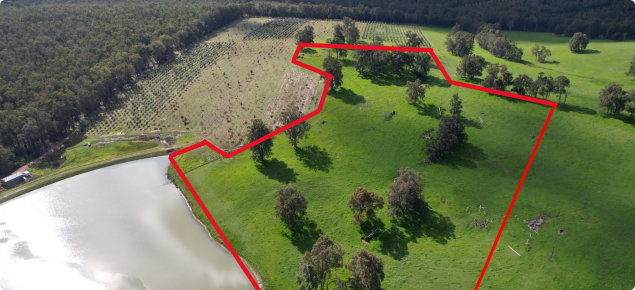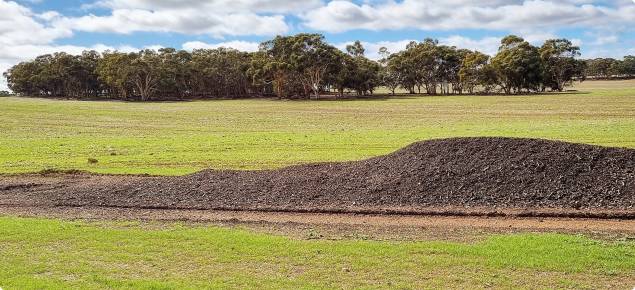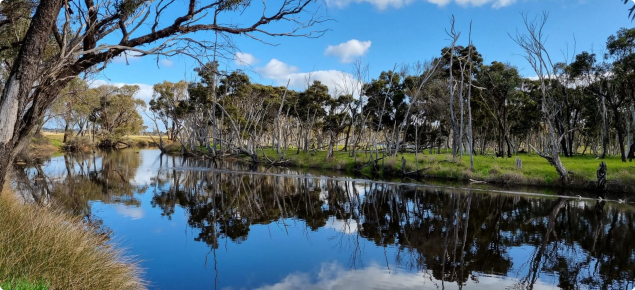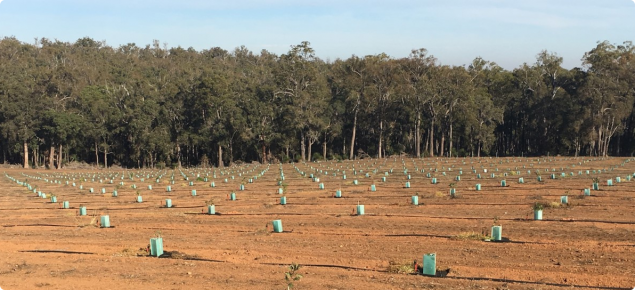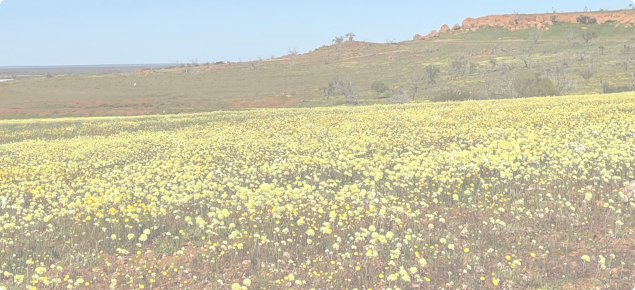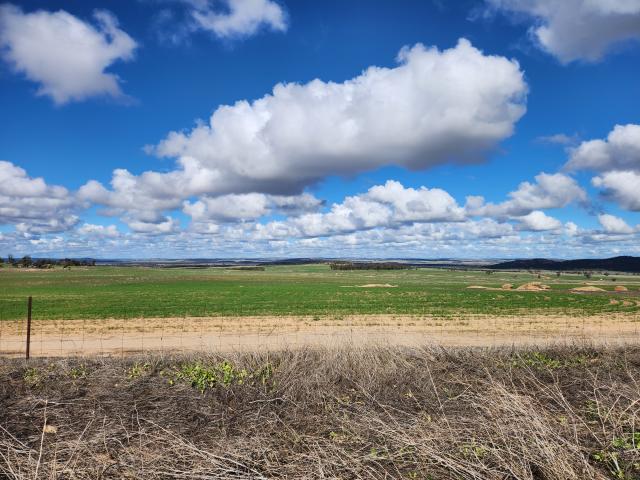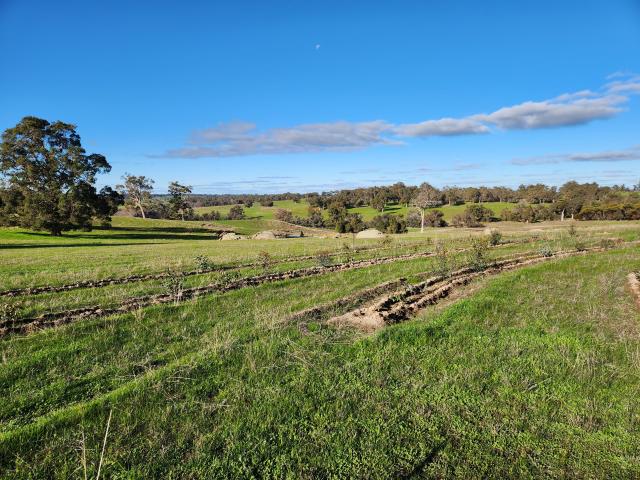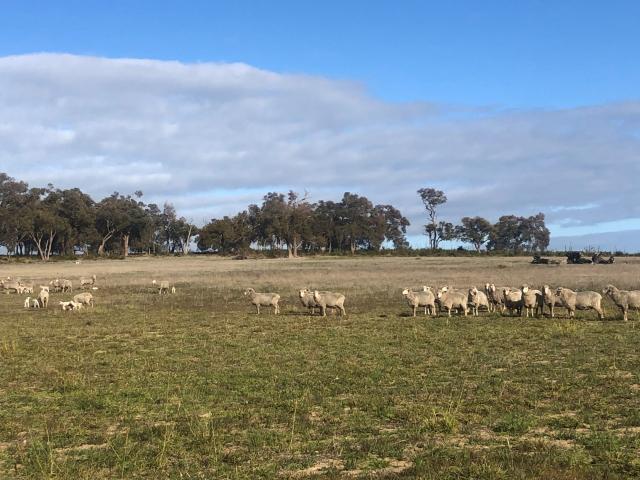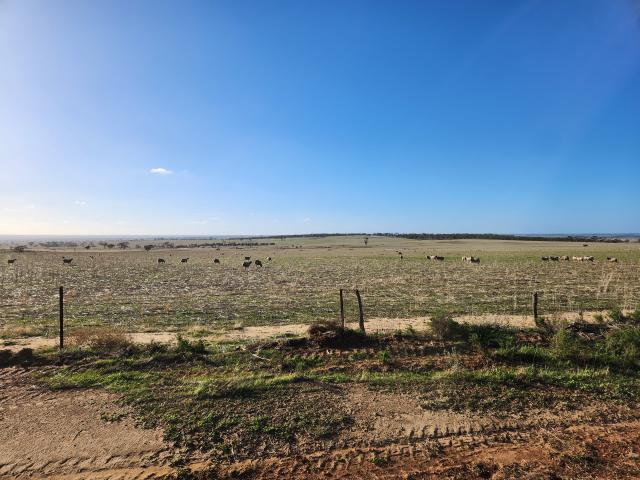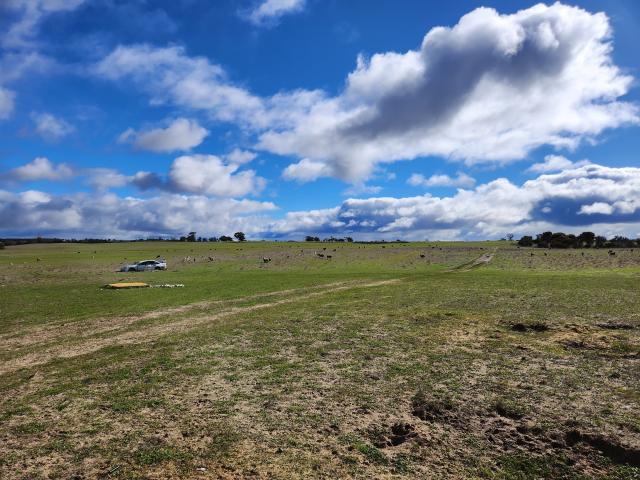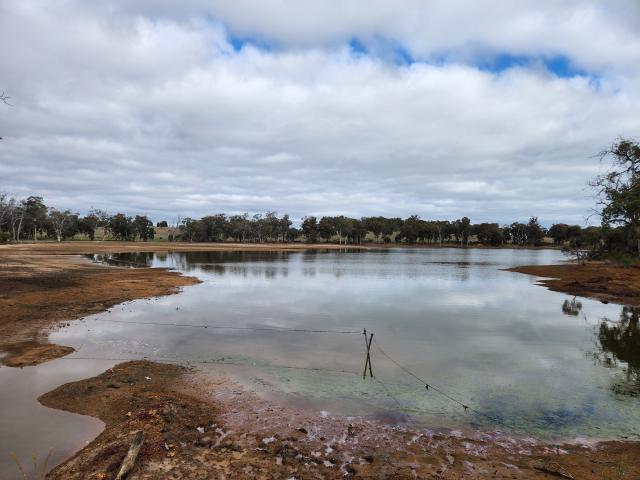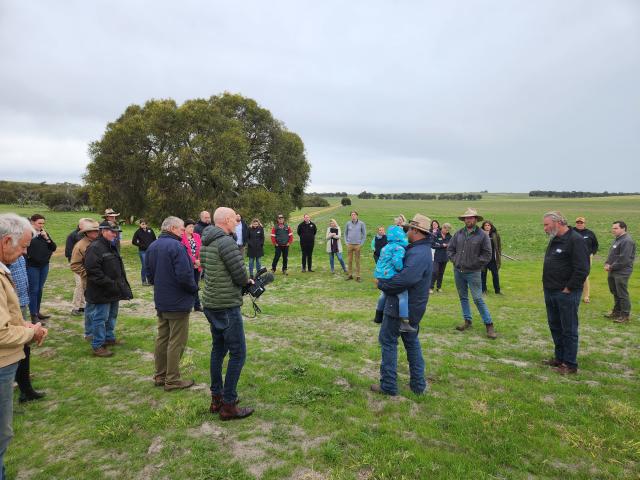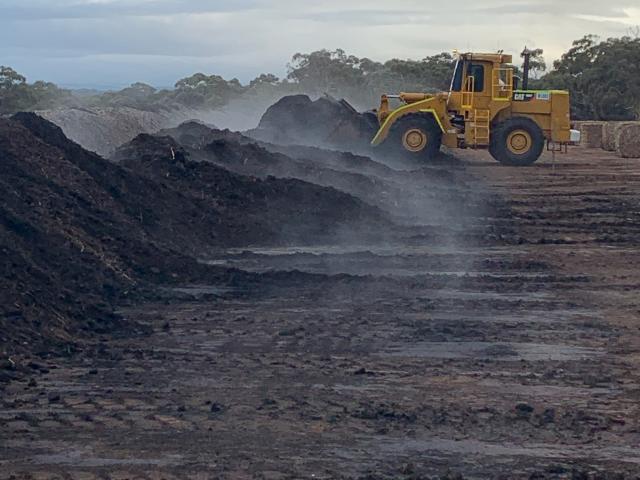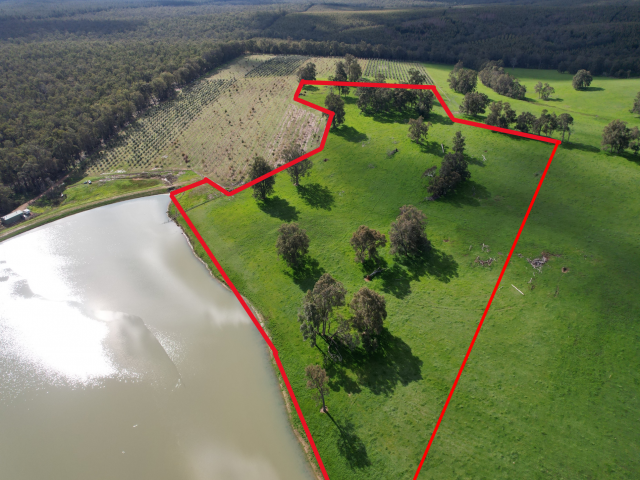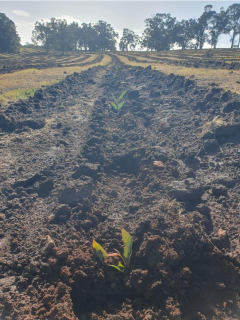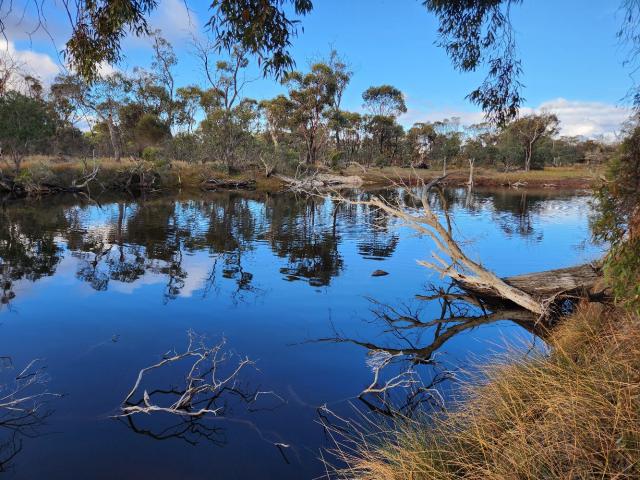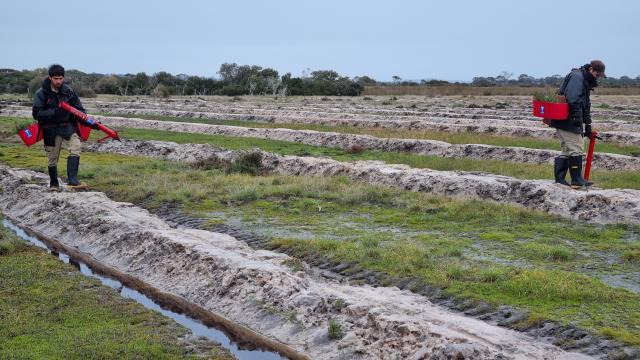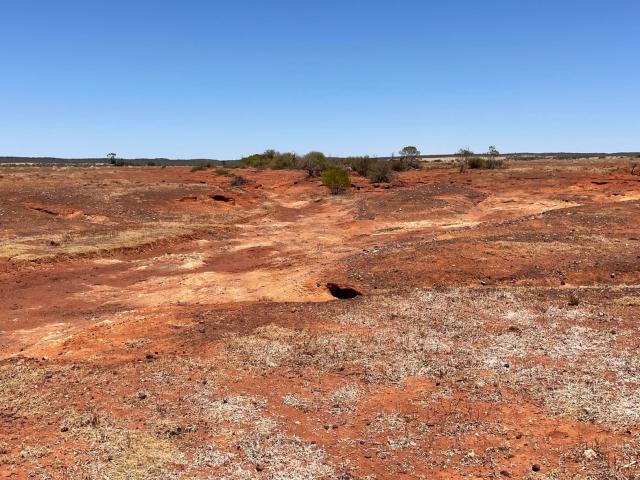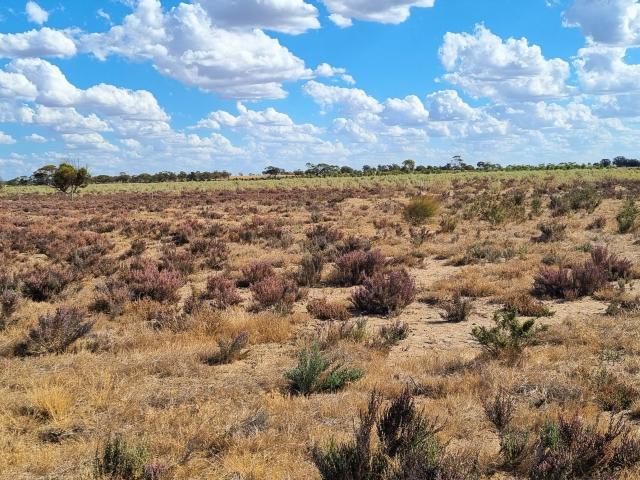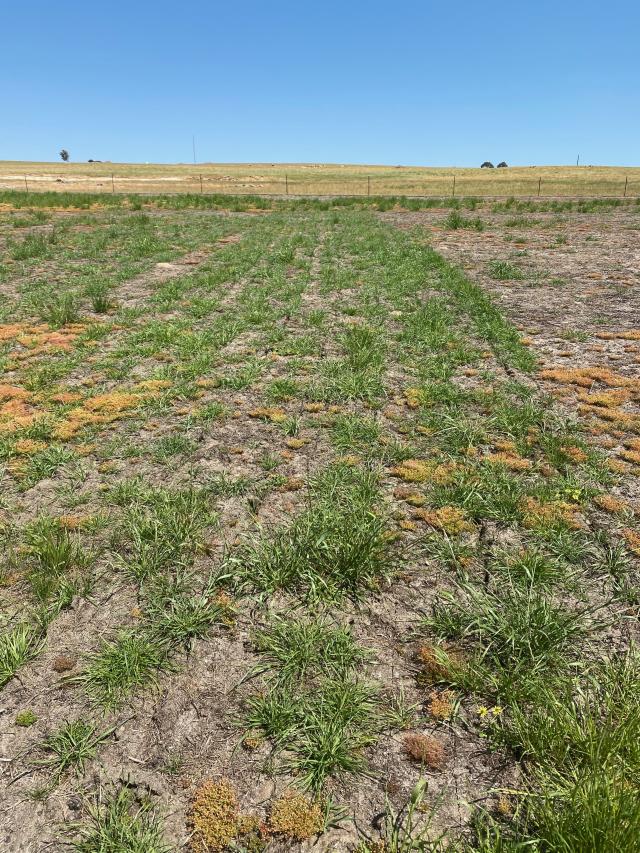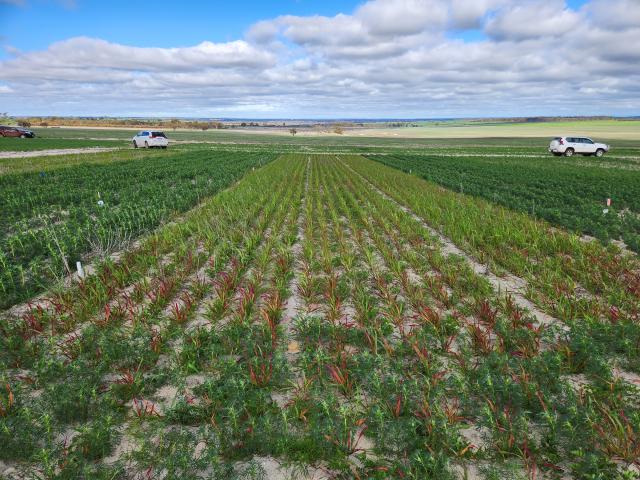CF-LRP Round 1 and 2
The Western Australian Government's $15 million CF-LRP aims to realise agriculture's potential to sequester carbon in the landscape, generate carbon credits and grow the State’s carbon farming industry. Projects selected will deliver carbon sequestration and environmental, economic, and social co-benefits, and contribute to the long-term sustainability of the farming industry.
The successful ACCU Plus projects are projected to remove a combined total of 829,000 tonnes of carbon dioxide from the atmosphere over the next decade in exchange for Australian Carbon Credit Units (ACCUs), alongside the Future Carbon initiatives supporting on-ground pilot research projects into carbon sequestration methods with the objective of better understanding carbon-capture activities suitable for Western Australia that may lead to the wide-scale adoption of new carbon farming practices.
Round 1
The Rural Business Development Corporation has entered Agreements for Financial Assistance with 6 ACCU Plus project proponents providing over $1.64 million in funding. The ACCU Plus projects span 5,807 hectares and expect to remove approximately 406,000 tonnes of carbon dioxide over the next 25 years.
Round 2
The Rural Business Development Corporation has offered financial assistance for 10 projects totalling over $2.15 million. The recipients are undertaking new or materially different carbon sequestration practices which include soil amelioration using clay, compost and manure, deep ripping, and applications of synthetic calcium to encourage long-term deep root development; mixed species legume fodder crops; revegetation with local (endemic) tree species; pasture rejuvenation, and cell grazing.
The projects span a total of 8,333 hectares and expect to remove approximately 423,000 tonnes of carbon dioxide from the atmosphere over 25 years.
Six of the 8 successful applicants were recipients from Round 1 of the Carbon for Farmers Vouchers Program which allowed them to engage professional advisory services which supported their applications to the CF-LRP Round 2. For more information about the voucher program click here.
Read about each of the successful projects on the next page or by selecting the case studies on the right side of this page or explore them on the map below:
Round 2 Case Studies
Lemonade Valley Biodiversity Project
Project Overview:
- Recipient: Lemonade Valley Pty Ltd
- Location: Mount Caroline (Kellerberrin), WA
- Total funding: $397,950
- Project size: 200 hectares
- Estimated ACCUs: 29,164
- Project method: Reforestation by Environmental or Mallee Plantings - FullCAM
- restore cleared land to native forest and reconnect areas of remnant bush;
- promote diversity in vegetation through the construction of a fence to protect young plants and facilitate feral animal and pest control;
- establish a mix of native flowering trees that can be used for honey production to support the commercial viability of the project;
- improvement soil quality through increased biodiversity and salinity and soil erosion reduction.
Hacienda De Trigo Soil & Endemic Vegetation Carbon Project
Project Overview:
- Recipient: Hacienda De Trigo
- Location: Corrigin, WA
- Total funding: $140,000
- Project size: 1507 hectares
- Estimated ACCUs: 84,543
- Project methods: Reforestation by Environmental or Mallee Plantings – FullCAM; and Estimating soil organic carbon sequestration using measurement and models method.
The Hacienda De Trigo Soil and Endemic Vegetation Carbon Project combines a soil carbon project over 1307 hectares and a reforestation by environment plantings over 200 hectares on the recipient’s property 8 km northwest of Corrigin. The vegetation project focuses on land restoration by planting mixed, endemic species to increase biodiversity. The soil carbon project focuses on improving soil health through practices which also aim to increase soil carbon sequestration. New practises include very deep ripping, ameliorating soil with clay, compost and manure, and introducing mixed legume species fodder crops.
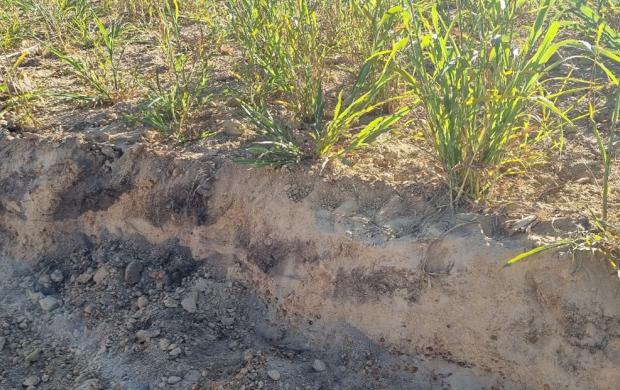
History of the project area
The designated project areas have an annual average rainfall of 370mm (since 1910). The soil types are typically sandy, with areas of gravel and subsoils that are typically duplex with low levels of clay content. There are areas of remnant woodland that have generally been fenced off to livestock and small areas of saline encroachment in some valleys. For the last 10 years, the land has been used for intensive broad acre cropping and livestock grazing, with sheep and cattle pasture. The project areas have been managed with a broadacre no tillage farming system with crop residue retention. The pasture phase has typically encompassed a single species cereal fodder crop.
Project details
The vegetation project focuses on land restoration by planting mixed, endemic species with the aim to sequester carbon and increase biodiversity. Site preparation includes fencing and weed control from 12 months prior to planting. The tree planting machine will be a sit-in Chatfield's tree planter with scalping and moulding discs and deep ripping tine. Infill planting will occur in the first 12 months after the initial planting and will continue throughout the project as required. The extent of area required for infill will dictate the method used, but it is expected this will be mainly using hand planters.
The plantings will provide multiple on-farm co-benefits, including increasing the biodiversity value of revegetation by linking endemic planting with existing tracks of remnant vegetation and improving resilience of agricultural practices by preventing wind erosion on vulnerable light sandy soils.
The soil carbon project aims to improve soil health and increase carbon sequestration through new practices to the farming business. These include very deep ripping, ameliorating soil with clay, compost and manure, and introducing mixed legume species fodder crops. The project estimates that it can increase soil organic carbon (SOC) levels from 0.8% to 1.3% in the top 30cm, which would generate 3.1 ACCUs/ha/year during the 25-year timeframe.
Dirty Clean Food – Regenerative Farmer Tree Project
Project Overview:
- Recipient: Wide Open Agriculture
- Location: Boyup Brook, Maya, Buntine, Williams and Kendenup, WA
- Total funding: $174,533
- Project size: 197 hectares
- Estimated ACCUs: 39,567
- Project method: Reforestation by Environmental or Mallee Plantings – FullCAM (Aggregated Project).
This project achieve several co-benefits including improved biodiversity, landscape rehydration, nutrient flow management, improved ecological health and diversity, remanent vegetation linkages, and livestock shade and shelter.
Over the past 5-10 years, the project properties have been used for intensive broad acre cropping and/or livestock grazing. Most of the project areas have had pasture phases during this period, with some areas being long term annual pasture for 10 years.
The aggregator will co-fund the project establishment phase with farmers from its supplier network. In return for the project co-funding, the aggregator will receive a small percentage of the carbon credits ACCU's generated by the project.
Site preparation will include pre-ripping, followed by spraying rip lines with registered non-selective herbicide. Seedling planting will use a Chatfield's "one-pass" planter that scalps, rips, mounds, plants seedlings and press wheels them in.
During establishment operations, the farmers will undertake weed control by using light topsoil scalping to remove competitive annual species from near the establishing woodland species. A “non-selective” herbicide will be considered for use prior to establishment operations. Post-establishment, slashing of plants growing in the "inter-rows" will be used where appropriate. Insect management monitoring will occur in the months following the establishment.
Red Gully Farm (RGF) Carbon Project
Project Overview:
- Recipient: AL Ruse
- Location: Boonanarring, WA (Gingin)
- Total funding: $150,000
- Project size: 975 hectares
- Estimated ACCUs: 99,136
- Project methods: Reforestation by Environmental or Mallee Plantings – FullCAM; and Estimating soil organic carbon sequestration using measurement and models method.
The landholder's passion for soil health and his understanding of the constraints to soil carbon maintenance in productive agricultural systems are the primary drivers to create a long-term plan for Red Gully Farm's future management.
Historically, Red Gully Farm has been managed with a low-input system over the past decade, with sheep used to stimulate and nourish native pasture species and help develop pasture diversity across the property. Establishment of pastures by seeding has been the main agricultural intervention, though low levels of diversity of species has been the prevalent practice. Sheep numbers have not been excessive though grazing systems management has been constrained by large paddock sizes.
Using good grazing management and well-placed strips of vegetation as wind-breaks, the project aims to minimise the constraints to the increase and/or maintenance of soil organic carbon levels. Minimising wind erosion and eliminating the use of biocides will be the cornerstones of this project, which aims to improve ecological outcomes and stimulate nutrient transfer across the site to prove the value of biodiversity for productive agricultural land.
Daraining Springs Project
Project Overview:
- Recipient: Hayes-Thompson & Co
- Location: Korbel, WA (Merredin)
- Total funding: $348,140
- Project size: 438 hectares
- Estimated ACCUs: 11,826
- Project method: Estimating soil organic carbon sequestration using measurement and models method
The farm covers an area of over 5400 hectares and is a broadacre, mixed enterprise with 2/3 cropping and 1/3 multipurpose sheep. Currently, cropping is usually on a 3-year rotation and the owners implement the strip and disc system to improve biomass yield and soil protection. Sheep are rotated through allocated pasture paddocks of grasses and limited clover and stubble throughout the year.
This project will see over 400ha of marginal crop land be converted to permanent pasture which will be control grazed (cells) and support an increase of carbon sequestration, whilst building a more resilient business. The recipient will measure soil organic carbon, soil nutrients, soil biology, number of sheep per grazed hectare, live weight of lambs and lambing percentage.
Tambellup Noongar Farm Carbon Restoration Project
Project Overview:
- Recipient: Native Carbon 3
- Location: Tambellup, WA
- Total funding: $607,750
- Project size: 130 hectares
- Estimated ACCUs: 22,100
- Project method: Reforestation by Environmental or Mallee Plantings – FullCAM
Wandoo Springs Soil Carbon Project
Project Overview:
- Location: Trigwell (Boyanup)
- Total funding: $172,000
- Recipient: Trustee for Vermac Trust
- Project size: 762 hectares
- Estimated ACCUs: 73,646
- Project method: Estimating soil organic carbon sequestration using measurement and models method.
This project will improve soil health and increase soil organic carbon stocks on land used for raising beef and sheep at Wandoo Springs, an 847ha property in Trigwell, WA. The project will install fencing, dams, pipes and troughs to increase the number of paddocks on the property. This will enable Holistic Grazing Management to be implemented, which will see an altering of stocking rate, intensity and duration of grazing, resulting in 100% ground cover, 100% of the time.
This project will demonstrate how adopting Holistic Grazing Management allows a build-up of soil organic carbon, leading to improved pasture growth. It will demonstrate how improving soil carbon can enhance soil microbial health, leading to improved pasture biomass/diversity and enhanced livestock production.
GFB Grazing Soil Carbon Project
Project Overview:
- Recipient: GFB Grazing Pty Ltd
- Location: Yathroo, WA
- Total funding: $166,901
- Project size: 4124 hectares
- Estimated ACCUs: 63,121
- Project method: Estimating soil organic carbon sequestration using measurement and models method.
This project will pioneer the progression of soil health improvements while simultaneously improving the profitability of the enterprise through:
- improved management practices
- increasing soil carbon to depths of at least 1.2m
- increasing native species biodiversity which have previously been eradicated due to set stocking regimes
- increasing soil humus and the regeneration of key soil nutrients.
Historically, livestock grazing has been the predominant activity undertaken during the baseline period. 700 ha of the property has been under Tagasaste (perennial legume) for a considerable amount of time and utilised for autumn high quality grazing. A proportion of the property has also been sown to cover crops for the baseline period to assist with improving soil organic carbon levels. The property has been managed by matching its stocking rate with its carrying capacity. The enterprise also trades cattle to allow for more flexibility with stock numbers and ensures limited degradation of the landscape.
Round 1 Case Studies
Undanooka Soil Carbon Project
Project Overview:
- Recipient: D & M Mackie Pty Ltd
- Location: Koojan (New Norcia), WA
- Total funding: $155,000
- Project size: 1600 hectares
- Estimated ACCUs: 66,500
- Project method: Estimation of Soil Organic Carbon Sequestration using Measurement and Models
- Permanence period: 25 years
The Undanooka Soil Carbon project will introduce legume species in cropping systems on the landholder’s property in Koojan WA, where hay and grain production with significant inputs of fertiliser and chemicals has occurred since animal production ceased in 2009.
The new management activity involves seeding a low rate of a legume species as a sub-storey crop. An air-seeder will be used to seed two or more plants at once, including the legume ‘partner’. The legume maintains a lower profile than the main production crop and provides value by fixing nitrogen. At the system level there are more diverse inputs, including greater root mass.
Under this practice, root biomass is expected to increase, along with soil bacterial and fungal biomass, which are sources of soil carbon. The legume intercropping will utilise canola as the primary harvested crop. Seradella will be used as the ‘non-harvested’ legume and clover will be cultivated under canola. Co-cultivation of canola with lupins will occur in some areas of the project. In this case, both the canola seed and lupin kernel will be harvested. These seeds will be separated after harvest using a seed grader and sold. Other management changes across the cropping land will be made in accordance with soil research findings and practical observations of the land over coming years.
The project activities will provide multiple on-farm co-benefits including increasing the resilience of agricultural practices by increasing ground cover to project soil biology from extreme temperatures, increasing agricultural productivity and improving soil health by retaining moisture in the soil profile.
2023 Project Update
Since receiving CER registration, the proponents have completed their baseline core and soil sampling and commenced new activities of co-species cultivation with vetch and oats across 400ha of the project area. They plan to extend this to cover 1600ha over the next 4 years.
Nannup Truffle Farm Carbon Sequestration Project
Project Overview:
- Recipient: Nannup Truffle Farm Pty Ltd
- Location: Nannup, WA
- Total funding: $50,000
- Project size: 7 hectares
- Estimated ACCUs: 3,834
- Project method: Reforestation by Environmental or Mallee Plantings—FullCAM
- Permanence period: 25 years
The Nannup Truffle Farm Carbon Sequestration Project will monitor and assess the economic outcomes of carbon farming, with a view to participate in large scale and long-term commercial outcomes. The project seeks to revegetate 7 hectares through the planting of 10,500 local native species via a combination of manual tube stock planting and direct seeding on land previously used as pasture for cattle.
The adjacent land has had over 20 years super phosphate synthetic chemical application, resulting in water source contamination and toxic algal blooms. This has the potential to wipe out the current intensive agriculture project of the established truffiere. Revegetating the proximity of the water source not suitable for truffle production is seeking to achieve three outcomes:
- Assessment of carbon farming as a potential commercial enterprise on low productivity land.
- Redress implications of bad soil management practices.
- Assess and increase resilience for agricultural productivity.
The Recipient provided an update at the Round 2 Announcement Forum:
Click here to view the Nannup Truffle Farm Carbon Sequestration Project presentation.
Listen to the audio of the presentation below:
2023 Project Update
The project began with pre-ripped with scalped rows, with over 15,000 seedlings planted at a rate of 1500 stems per hectare. The 28 species planted are only those that are endemic to the Nannup region. Despite some waterlogging in the planting area, there has been an over 80% plant survival rate since planting.
The proponent has also undergone soil and water testing to establish a baseline to measure the impact of planting on the quality of the soil and water over the life of the project.
Boorokup Restoration Project
Project Overview:
- Recipient: Native Carbon 2
- Location: Cranbook, WA
- Total funding: $540,000
- Project size: 250 hectares
- Estimated ACCUs: 48,000
- Project method: Reforestation by Environmental or Mallee Plantings – FullCAM
- Permanence period: 100 years
The 358-ha demonstration site in Cranbrook, WA is establishing best practice through the revegetation of 250 hectares of degraded, low value farmland. Revegetation is being implemented using both direct seeding and hand planting to achieve diverse restoration at-scale.
The project has been designed to meet 5-star ecological restoration on a complex mosaic of soil types in a hydrological ‘at risk’ area by reducing habitat fragmentation between remnant patches of vegetation along the Gordon River.
The project will provide an opportunity for farming groups and individuals to understand localised restoration options for low and non-yielding soils in a hydrological ‘at risk’ area. Baseline and concluding salinity surveys will map the location, extent and severity of salinity, soil electrical conductivity and biomass mapping using satellite imagery.
The project will be co-designed with local Traditional owners. Indigenous Australians including the Binalup Rangers are employed for restoration, delivery and research programs. In addition to Aboriginal economic development, the Project will provide other on-farm co-benefits including salinity mitigation (lowering water table to improve soils), increasing the biodiversity value of revegetation and landscape connectivity.
Project manager Justin Jonson provided an update at the Round 2 Announcement Forum:
Click here to view the Boorokup Restoration Project presentation,
Listen to the audio of the presentation below:
2023 Project Update
Over 210ha have been planted and seeded this year through a combination of direct planting and seeding. The proponent has engaged 10 members of the local Aboriginal Community, the Binalup rangers, who have assisted with planting and fencing (pictured). In 2024, the project aims to infill planting and replant in some areas were waterlogging prevented planting, and in more sandy areas which had a lower-than-expected success rate.
Weelhamby Farm Biodiversity & Carbon Projects
Project Overview:
- Recipient: Weelhamby Land Pty Ltd
- Location: Perenjori, WA
- Total funding: $738,600
- Project size: 3200 hectares
- Estimated ACCUs: 170,000
- Project methods: Reforestation by Environmental or Mallee Plantings – FullCAM; and
- Estimating soil organic carbon sequestration using measurement and models method.
Weelhamby Farm is in an area noted for its biodiversity significance and is surrounded on three sides by nature reserves. Due to past cropping and pasture management techniques that were not designed to support the build-up of carbon and soil health, sampling shows the average soil organic carbon on the land is currently very low. The project focuses on improving soil health and sequestering carbon in soil as priority outcomes from operating a profitable agricultural production enterprise across at least much of the land.
The project will see the adoption of new management practices, including a three-year pasture to one-year cropping rotation, with pulse grazing of pastures by sheep to improve soil microbial and fungal activity, water infiltration and water holding capacity in the soil, and build soil organic carbon in the top one metre of soil on farm in the next 25 years. Around 250 ha of biodiverse revegetation plantings in belts around the farm are also designed to increase productivity and biodiversity.
The project will provide significant agricultural, biodiversity and landscape management co-benefits. Weelhamby is intended as a public demonstration farm, hosting field days, and regularly sharing updates and economic outcomes with the agricultural community.
Proponent David Martin provided an update at the Round 2 Announcement Forum:
View the project update and listen to the audio of the presentation below:
Biodiversity Project (230 ha)
The plantings will provide multiple on-farm co-benefits, including windbreaks to reduce wind erosion, shelter for stock, and increased water infiltration by slowing the movement of water across the landscape.
The revegetation program will be implemented using manual and machine tube stock planting and direct seeding of understory species. A biodiversity baseline report will guide decisions on optimal planting areas, supported by a detailed landscape analysis.
There will be a combination of small block plantings on areas of the farm not suited to agriculture and adjacent to existing remnant vegetation on the property to extend habitat for mallee fowl and other threatened species. Wide belt plantings along existing and new fence lines to create wildlife corridors linking 1,500 ha of remnant vegetation with the three nature reserves adjoining the property. The belts will also divide existing paddocks into smaller grazing areas (cell grazing).
An independent ecological assessment will verify landscape connectivity values as part of the proposed 3-year outcomes report, in addition to reports measuring the impacts and outcomes of both projects every 3-5 years.
One of the aims of this project is to build soil organic carbon over the next 25 years. The farmer chose an independent agronomist with extensive local experience to support the project. The farmer and the agronomist worked together to design a new land management strategy, shifting from high input cereal cropping, towards a rotational grazing enterprise with multi-species perennial pasture. A biological inputs program was also implemented.
The proponent will use annual farm management records as a data source to benchmark the project’s performance against historical measures such as stocking rates, crop yields, fertilisers and other inputs (mineral, chemical and biological).
Soil and salinity impacts will be measured by mapping the extent, location and severity using satellite imagery and electromagnetic induction. Avoided loss of topsoil from wind and water erosion will be achieved through year-round ground cover, as well as minimisation of water run-off and increasing the water holding capacity of the soil.
This project will re-establish pasture by seeding a mix of annual and deep-rooted perennial grasses and legumes to encourage and facilitate significant build up in soil microbial and fungal activity. The planting of multi-species pasture crops will include perennial grasses and legumes across all grazing areas. The addition of legumes to the mix of seeds sown is to be a significant change for the property and is expected to make a positive difference to available soil nitrogen levels.
The project estimates that it can increase soil organic carbon levels from 0.7% to 1.2% in the top 30cm. The project has nominated a 100-year carbon permanence period, which will allow for the creation of long-term carbon and environmental outcomes.
2023 Project Updates
Approximately 90% of the cleared land on the farm has been included in the project; the soil project area will cover around 81% of the property, and the vegetation project, combined with a buffer zone, laneways and areas unsuitable for farming making up the remaining 9%. Across the vegetation project area, 70,000 seedlings have been planted using a combination of machine, hand, and direct seeding across 233 hectares. Over 350 soil samples have been collected to create a baseline and understanding of the property’s soil.
A biodiversity baseline was commissioned by ecologist Dr Judith Fisher across remnant vegetation and some areas of pasture, and a biodiversity database has been created using a combination of drone and digital technology. The project proponent held a site visit to identify ideas of cultural significance with Traditional Owners, Yamatji Southern Regional Corporation Ltd (YSCR) and a representative from the Department of Planning, Lands and Heritage (DPLH).
Across the soil project, a combination of pastures and crops were seeded, including serradella, corn rye, safflower, canola, wheat, oats, vetch, lupins, and linseed. Several treatments have been added across the soil project area, including microbial and fungal seed dressings, organic compost, lime and guano. In addition to plantings, Weelhamby Farm gained Elders’ ‘Responsible Wool Standard’ (RWS) Certification and will be fully certified organic in 2024, with much of the farm already certified.
Wellwood Farm Carbon Project
Project Overview:
- Recipient: KJ Barrett & LM Barrett & SJ Barrett
- Location: Badgebup and Nyabing, (Katanning) WA
- Total funding: $160,000
- Project size: 2000
- Estimated ACCUs: 83,160
- Project method: Estimation of Soil Organic Carbon Sequestration using Measurement and Models
- Project permanence: 25 years
2023 Project Update
Since receiving CER registration, the proponents have sampled across their 2000ha project area and introduced cover crops as a new activity across 250ha. In 2024, they will expand this area and introduce other new activities, including no-till practices, extending the cover crop area, altering the stocking rate, and grazing intensity, and retaining stubble after harvest.
Future Carbon Projects
The Future Carbon stream of the CF-LRP is aimed at the development of new or amended CER carbon sequestration methods, and those that enhance the undestanding of farming activities that sequester carbon.
Grazing into the Future
Project Overview:
- Recipient: University of Western Australia
- Location: West Pingelly, WA
- Total funding: $371,634
2023 Project Update
The pasture trial site was established at UWA Farm (Ridgefield) on an existing annual pasture. A range of treatments have been applied, including perennial pasture species mixed with annual pasture species with a range of soil biological amendments such as biochar, digestate and compost. To help quantify the impact of the trial, soil baselines have been established, including a measure of carbon stock levels.
Green Waste to Net Zero (Biochar Program)
Project Overview:
- Recipient: Wilson Inlet Catchment Committee
- Location: Denmark, WA
- Total funding: $52,914
Using Living Plant Systems
Project Overview:
- Recipient: Soil CRC (CRC for High Performance Soils)
- Location: sites across Bullaring, Kweda, Coorow, Wathingarra
- Total funding: $600,000
A collaborative framework for investments in soil carbon, soil health and sustainability will involve a value-add approach with complementary soils investments about to take place in Western Australia from the Soil CRC.
2023 Project Update
Across the 4 trial sites, SoilCRC are working with Liebe, Murdoch University, CFIG and West Midlands Group to plant perennial varieties such as lebeckia, lucerne and saltbush, seradella. This has been done alongside several soil amendments, including bentonite clay, chicken manure, and bednar, as well as trialing the use of deep ripping. SoilCRC has been working with Liebe Group and West Midland Group to assist in the running of this trial, working across the sites.
You can listen to WMG ‘Paddock Chat’ podcast episode which includes a discussion on the FutureCarbon Project here.Wheatbelt NRM Saltbush Research Project
Project Overview:
- Recipient: Wheatbelt NRM
- Location: sites across East Pingelly, Highbury, Corrigin, Kulin and Yiliminning
- Total funding: $616,263
Working with Murdoch University, this project will scope the viability of saltbush to sequester carbon and provide data to make the case for the development of a Methodology under the Carbon Credits (Carbon Farming Initiative) Act 2011. A time-sequencing approach will be used to measure actual sequestration rates using existing stands aged up to 35 years. This component will provide a report on the viability of a saltbush-based Methodology in year two of the project. Concurrently, the project will establish 6 new planting sites to become the basis for further investigation; including estimation of carbon sequestration with different saltbush species,planting densities and site management. Read more on Wheatbelt NRM's website.
Professor Richard Harper presented on this Future Carbon project on behalf of the project collaborators - access the audio by clicking on the play-button below.
2023 Project Update
This project is a combined collaboration with WheatbeltNRM working alongside CFIG, Facey Group and Murdoch University to manage plantings across 6 farms in the planting plot trial project. Contracts have been signed and planting has occurred at all properties. Across each of the 20-hectare sites, 3 species have been trialed at different densities: Atriplex nummularia (oldman and anameka subspecies), and semibaccata.

